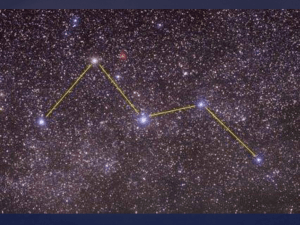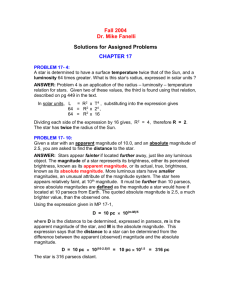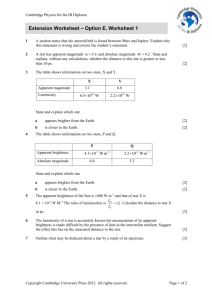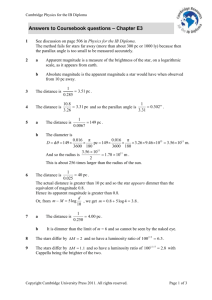Solutions
advertisement
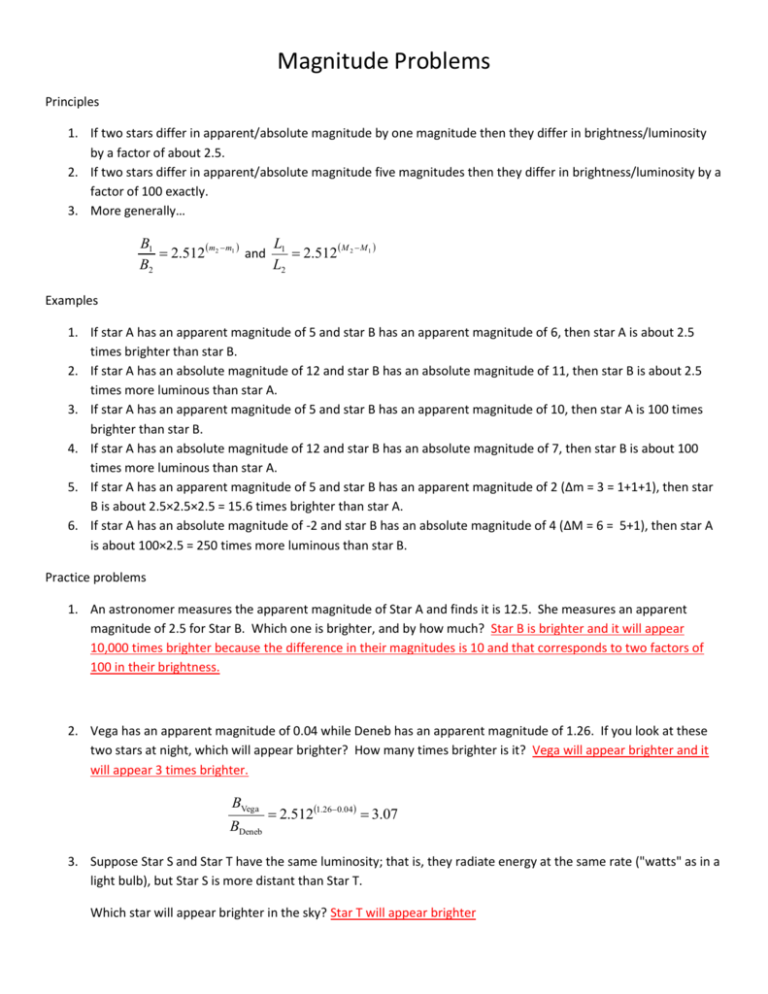
Magnitude Problems Principles 1. If two stars differ in apparent/absolute magnitude by one magnitude then they differ in brightness/luminosity by a factor of about 2.5. 2. If two stars differ in apparent/absolute magnitude five magnitudes then they differ in brightness/luminosity by a factor of 100 exactly. 3. More generally… B1 L 2.512 m2 m1 and 1 2.512 M 2 M 1 B2 L2 Examples 1. If star A has an apparent magnitude of 5 and star B has an apparent magnitude of 6, then star A is about 2.5 times brighter than star B. 2. If star A has an absolute magnitude of 12 and star B has an absolute magnitude of 11, then star B is about 2.5 times more luminous than star A. 3. If star A has an apparent magnitude of 5 and star B has an apparent magnitude of 10, then star A is 100 times brighter than star B. 4. If star A has an absolute magnitude of 12 and star B has an absolute magnitude of 7, then star B is about 100 times more luminous than star A. 5. If star A has an apparent magnitude of 5 and star B has an apparent magnitude of 2 (Δm = 3 = 1+1+1), then star B is about 2.5×2.5×2.5 = 15.6 times brighter than star A. 6. If star A has an absolute magnitude of -2 and star B has an absolute magnitude of 4 (ΔM = 6 = 5+1), then star A is about 100×2.5 = 250 times more luminous than star B. Practice problems 1. An astronomer measures the apparent magnitude of Star A and finds it is 12.5. She measures an apparent magnitude of 2.5 for Star B. Which one is brighter, and by how much? Star B is brighter and it will appear 10,000 times brighter because the difference in their magnitudes is 10 and that corresponds to two factors of 100 in their brightness. 2. Vega has an apparent magnitude of 0.04 while Deneb has an apparent magnitude of 1.26. If you look at these two stars at night, which will appear brighter? How many times brighter is it? Vega will appear brighter and it will appear 3 times brighter. BVega BDeneb 2.5121.260.04 3.07 3. Suppose Star S and Star T have the same luminosity; that is, they radiate energy at the same rate ("watts" as in a light bulb), but Star S is more distant than Star T. Which star will appear brighter in the sky? Star T will appear brighter Which will have the greater apparent magnitude? Star T will have a numerically greater apparent magnitude Two supernovae occur in different galaxies. If both supernovae have the same luminosity, how will you tell which galaxy is more distant? The dimmer supernova is in the more distant galaxy. 4. If a supernova has an absolute visual magnitude of -25, what is its visual luminosity in terms of the Sun's luminosity? LSupernova LSun 2.5124.8 25 8.33 1011 The Supernova is 833 Billion times more luminous than the Sun. 5. Below is a table of stars. Common Name Sun Canopus Deneb Barnard's Star Sirius A Sirius B Apparent Magnitude -26.72 -0.72 1.25 9.54 -1.46 8.3 Absolute Magnitude 4.8 -2.5 -7.2 13.2 1.4 11.2 Spectral Type Luminosity Class G2V A9II A2Ia M3.8V A1Vm DA a. How many times brighter is Deneb compared to Sirius B? Since the difference in magnitudes between Deneb and Sirius B is (8.3-1.25) = 7.05 = 5 +1+1+.05, then Deneb is about 100×2.5×2.5 = 625 times brighter than Sirius B. (Note: I ignored the small effect of the 0.05 magnitude term.) - or - BDeneb 2.5128.31.25 661 (Best method) BSirius B So Deneb is 625 or 661 times brighter than Sirius B (depending on method). b. How many times more luminous is Deneb compared to Sirius B? Since the difference in magnitudes between Deneb and Sirius B is (11.2- -7.2) = 18.4 = 5 +5+5+1+1+1+.4, then Deneb is about 100×100×100×2.5×2.5×2.5× 1.5= 23.4 million times more luminous than Sirius B. (Note: I approximated the effect of the 0.4 magnitude term with a multiplicative factor of 1.5.) - or - LDeneb 2.51211.2 7.2 22.9 106 (Best method) LSirius B So Deneb is about 23 million times more luminous than Sirius B. c. How many times brighter is Barnard’s Star compared to Canopus? Since the difference in magnitudes between Canopus and Barnard’s Star is (9.54—0.72) = 10.26 = 5 +5+0.26, then Canopus is about 100×100×1.3 = 13,000 times brighter than Barnard’s Star. (Note: I approximated the effect of the 0.26 magnitude term with a multiplicative factor of 1.3.) - or - BCanopus BBarnard's Star 2.5129.54 0.72 12,712 (Best method) So Canopus is about 13,000 times brighter than Barnard’s Star (depending on method). d. How many times more luminous is Barnard’s Star compared to Canopus Since the difference in magnitudes between Canopus and Barnard’s Star is (13.2- -2.5) = 15.7 = 5 +5+5+0.7, then Canopus is about 100×100×100×2 = 2 million times more luminous than Barnard’s Star. Note I approximated the 0.7 magnitude term with a multiplicative factor of 2. - or - LCanopus LBarnard's Star 2.51213.2 2.5 1.9 106 So Canopus is about 2 million times more luminous than Barnard’s Star. e. How many times brighter is the Sun compared to Deneb? Since the difference in magnitudes between Sun and Deneb is (1.25—26.72) = 27.97 = 5+5+5+5+5+5, then the Sun is about 100×100×100×100×100×100 = 1012 times brighter than Deneb. (Note: I ignored the small effect of the 0.03 magnitude term.) - or - BSun 2.5121.25 26.72 1.54 1011 (Best method) BDeneb So the Sun is one trillion or 154 billion times brighter than Deneb (depending on method). f. How many times more luminous is Sun compared to Deneb? Since the difference in magnitudes between Deneb and the Sun is (4.8—7.2) = 12 = 5+5+1+1, then Deneb is about 100×100×2.5×2.5 = 62,500 times more luminous than the Sun. - or - BDeneb 2.5124.8 7.2 63,129 (Best method) BSirius B So Deneb is about 63,000 times more luminous than the Sun (depending on method).


